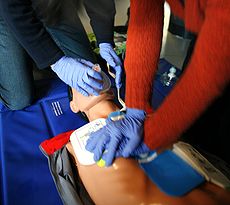Introduction
Cardiac arrest, also called cardiopulmonary arrest or circulatory arrest, is the cessation of normal circulation of the blood due to failure of the heart to contract effectively.
Without timely CPR and defibrillation, cardiac arrest will rapidly lead to death. Cardiac arrest can occur suddenly, without warning, due to a number of reasons. In patients who have terminal illness, cardiac arrest is the expected, final outcome of their disease.
When in the hospital, the response to cardiac arrest is often termed a ‘code’ or ‘code blue’.
Causes and Risk Factors
The majority of cardiac arrests are caused by acute coronary syndrome, or myocardial infarction (heart attack).
Other cardiac conditions that may lead to cardiac arrest include:
- arrhythmias, both brady- and tachy-
- genetic abnormalities, including Wolff-Parkinson-White syndrome, long QT syndrome, and Brugada syndrome
- congestive heart failure
- dilated or hypertrophic cardiomyopathy
- congenital structural or arterial abnormalities
- valvular disease, especially aortic valve stenosis, mitral valve stenosis
- myocarditis
- cardiac tamponade
- pulmonary hypertension
Non–cardiac causes of sudden cardiac death include:
- hyperkalemia
- hypokalemia
- pulmonary embolism
- acidosis (various causes)
- blunt or penetrating trauma to the chest
- non-trauma related bleeding (such as gastrointestinal bleeding, aortic rupture, and intracranial hemorrhage)
- overdose
- drowning
- hypoxia
- hypovolemia
- hyperkalemia
- hypokalemia
- hypoglycemia
- hypothermia
- hydrogen ions (acidosis)
- thrombosis (MI, PE)
- tension pneumothorax
- tamponade
- toxins/therapeutics
- trauma
Pathophysiology
main article: electrical control of the heart
Cardiac arrest occurs when meaningful heart rhythm ceases, causing the heart to be unable to effectively pump blood throughout the body. There are several different arrhythmias that cause cardiac arrest, which are termed ‘shockable’ and ‘non-shockable’, depending on their potential responsiveness to defibrillation:
shockable rhythms
|
non-shockable rhythms
|
Pulseless ventricular tachycardia (VT) is a rapid heart rhythm where the ventricles contract too quickly to allow for refilling in between beats. As the heart function becomes increasingly unstable, reentry circuits occur, where ventricular activity cycles on itself in chaotic patterns. These disorganized reentry circuits are thought to break up into smaller wavelets. These impulses wander throughout the ventricles, culminating in ventricular fibrillation (VF). VF normally represents the final activity occurring with cardiac arrest, where there is no coordination of ventricular contraction. If untreated, these discordant rhythms rapidly progress to a complete cessation of all electrical activity in the heart, which is called asystole.
Pulseless electrical activity (PEA) is a group of rhythms that are organized or semi-organized, but lack a discernible pulse. Examples include:
- idioventricular rhythms
- ventricular escape rhythms
- postdefibrillation idioventricular rhythms
- bradysystolic rhythms
Assessment of Cardiac Arrest
History
Due to inadequate cerebral perfusion, the patient will be unconscious and will have stopped breathing.
If possible, rapid efforts should be made to understand the patient’s symptoms prior to the event, as well as their health history.
Attempt to clarify code status to determine whether resuscitation should be attempted. If this information is unavailable, attempt resuscitation.
Sudden cardiac arrest may occur due to channelopathies – diseases affecting ion channels that may be inherited. Family history should be probed for events such as sudden death, syncope, seizure, or drowning.
Physical Exam
Cardiac arrest results in a lack of circulation. This may be demonstrated physically by:
- nonpalpable pulse – radial, or carotid
- lack of heart sounds
- evidence of non-perfusion – poor colour, no movement or agonal movement
- apnea or agonal breathing (nonproductive respirations, eg gasping, caused by brainstem reflexes)
However, an absent pulse can sometimes be difficult to identify with certainty. If suspicion is high, and resuscitation is warranted, emergency efforts should be started without delay.
Treatment

CPR; used with permission
If resuscitation is warranted, ie if the patient’s wishes are to be revived, CPR should begin immediately. This is further described under basic life support (BLS).
For shockable rhythms, the mainstay of treatment is defibrillation. It is highly important to recognize and treat shockable cardiac rhythms early, before they progress to non-shockable rhythms. This may be done through use of an AED or a manual defibrillator.
Advanced cardiac life support (ACLS) may also be provided, depending on the level of training of the provider. This includes use of IV medications such as epinephrine or amiodarone, as well as advanced airway management. For details regarding medications used in treating cardiac arrest, refer to Heart and Stroke Foundation Guidelines.
For any cardiac arrest, treating the cause (if known) is important to prevent the arrhythmia from recurring.
